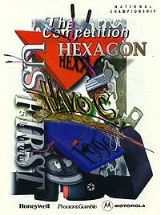
Hexagon Havoc
Encyclopedia
Hexagon Havoc was the 1996 game for the FIRST Robotics Competition
. Seeding games of 1-on-1-on-1 were played double-elimination
to determine the teams for the finals rounds. In the finals, robots played 1-on-1 in a best 2 out of 3.
car seat motors, and two Textron pneumatic pumps which. The robots were were powered by two 12 volt Milwaukee Drill batteries and operated through a customized remote-control system.
Points were awarded for balls located in the central goal at the conclusion of each two-minute match. Each small ball in or above the hexagonal portion of the central goal was worth three (3) points. Each large ball located in or above the hexagonal portion of the central goal was worth ten (10) points. Each large ball on or over the triangular corners of the goal was worth five (5) points. The team with the highest score in a match was the winner. In the case of a tie, the team with the highest large ball in the goal won. If no large balls were in the goal ties were broken by the large ball closest to the center of the goal.
FIRST Robotics Competition
The FIRST Robotics Competition is an international high school robotics competition organized by FIRST. Each year, teams of high school students compete to build robots weighing up to , not including battery and bumpers, that can complete a task, which changes every year...
. Seeding games of 1-on-1-on-1 were played double-elimination
Double-elimination tournament
A double-elimination tournament is a type of elimination tournament competition in which a participant ceases to be eligible to win the tournament's championship upon having lost two games or matches...
to determine the teams for the finals rounds. In the finals, robots played 1-on-1 in a best 2 out of 3.
Field
The playing field was a carpeted, hexagon-shaped area with a central goal. Around the perimeter of the field were three stations for the human players who assisted the remote controlled robots on the field to score points. There were twelve 8 in (20 cm) diameter balls and two 24 in (61 cm) diameter balls per team, color coded by team. At the start of each match, all of the small balls and three of the large balls are on the playing field, while the other three large balls are located on the triangular corners of the central goal.Robots
Each robot had to weigh no more than 120 lb (54 kg) and fit unconstrained inside a 36 in (91 cm) cube. The robots used two 12 volt Milwaukee drill motors, four DelcoDelco Electronics
Delco Electronics Corporation was the automotive electronics design and manufacturing subsidiary of General Motors based in Kokomo, Indiana.The name Delco came from the Dayton Engineering Laboratories Co., founded in Dayton, Ohio by Charles Kettering and Edward A...
car seat motors, and two Textron pneumatic pumps which. The robots were were powered by two 12 volt Milwaukee Drill batteries and operated through a customized remote-control system.
Scoring
In two-minute matches, the three robots, with their human partners, scored points by placing the balls in the central goal. The balls were carried, pushed or thrown into the goal by the robots. The human players could score by throwing balls into the central goal, but were not allowed on the playing field as they were seat-belted down at their stations.Points were awarded for balls located in the central goal at the conclusion of each two-minute match. Each small ball in or above the hexagonal portion of the central goal was worth three (3) points. Each large ball located in or above the hexagonal portion of the central goal was worth ten (10) points. Each large ball on or over the triangular corners of the goal was worth five (5) points. The team with the highest score in a match was the winner. In the case of a tie, the team with the highest large ball in the goal won. If no large balls were in the goal ties were broken by the large ball closest to the center of the goal.

